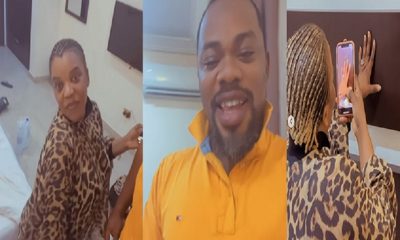Feature/OPED
Ericsson: Smart Home Privacy: How to Avoid ‘Data Paparazzi’

The paparazzi are known for often taking covert photographs of celebrities and selling them to tabloids or gossip magazines.
In a similar vein, could the increasing number of smart, connected devices coming into our lives start acting like covert “data paparazzi”? And what can we do to avoid it? Find out here.
Today, our devices collect and forward information to all sorts of external parties: our home security alarm provider, our electricity supplier, our fitness watch vendor, our car manufacturer, our security needs to be good enough that it deters attackers and so on. Smart assistants listen to our voice commands and take that information to the internet to execute our orders.
But smart devices go beyond the obvious too – they can be anything from a connected toaster to a washing machine, sewing machine, or a toothbrush!
Data from one device may not be a problem, but combining data from several devices could create a pattern that may reveal unwanted information about a user or a business. And with more devices coming into homes, concerns around the way personal data is managed, controlled and used by devices and organizations are increasingly being raised.
Each new device may introduce a new security risk, if not properly managed through its life cycle. The security risks must be handled by all actors in the value chain, including the device owner, regardless if devices are used by consumers, industries, or smart cities.
So what will be important to think about to ensure that users benefit and get value from devices and their related services, but avoid adding security issues? Should we risk unintentionally becoming surrounded by data paparazzi with their viewfinder aimed at us?
In this blog post, we’ll bring some light on to what these factors mean for the device owner and what can be done to confront it.
Smart devices and privacy: the big picture
Many of us already interact with at least 3 to 5 devices daily – a smartphone or even two, a smart watch, a tablet PC, a work laptop, and maybe a smart TV. One estimate is that by 2030, each of us will own 15 connected devices. Some devices, like a connected car or smart meter, are connected by default and typically managed by the company the user is a customer of. They typically rely on cellular connectivity. For many other devices, the users themselves select and provide the connectivity, often Wi-Fi or cellular, and are personally responsible for the management of the devices.
Above all, the network infrastructure and devices need to be secure. It’s important for us all that we can trust how our devices operate and handle data. It will also be important to ensure device security through the life cycle of the devices. With the fast growth and wide of range of smart and connected devices from different brands – that come with different user interfaces and functions – it might be cumbersome to keep all devices up to date in terms of firmware and security status, for example, from the day the device is purchased until its recycled. However, this is a key requirement for enabling a secure and trustworthy IoT environment.
GDPR and similar efforts have raised more attention to privacy from the general public. As people become more informed and want to know how their devices and information are used and managed, there will be an increased need for tools that enable identifying, verifying, and controlling the data the devices are collecting and sharing.
The data paparazzi problem
Let’s now go into some issues that celebrities have to deal with, regarding paparazzi and stalkers, and how similar situations can also occur in the IoT world. We’ll also reveal if similar mitigation strategies can work for both regular, and data paparazzi.
Information availability
While the saying goes that “all publicity is good publicity”, many celebrities wouldn’t agree. They want to be in control of the information shared about them, to build a relevant public image but avoid revealing private relations, unattractive personal habits, or similar.
The same thinking is behind IoT security; information that’s needed to complete the intended tasks of an IoT device should be made available, while the rest of the information should be kept private. However, for IoT there’s often a more fine-grained approach as the information made available should in many cases only be made available to a restricted group of observers on a need-to-know basis.
The stalker problem
Many celebrities might also have to deal with stalkers – individuals who are overly interested in them and may try to gain as much information about them as possible, even using illegal means.
In the IoT space, the same phenomenon could happen to the average Joe. A smart home that doesn’t restrict access to the information it generates can easily become a lucrative target for an attacker; the information generated by the home can be used to gather different information about the inhabitants, which could later be leveraged to commit a cyber attack. Information about when various appliances are used, such as when doors are opened, lights are switched on/off, energy consumption fluctuates, can be a real treasure trove. This also means that potential attackers might not skip a house just because there’s some security applied, rather the security needs to be good enough that it deters attackers from trying, or stops them in their tracks.
Mitigation strategies
Celebrities tend to take precautions to hinder paparazzi and stalkers from invading their privacy. This can be in the form of living in gated communities or at least having access control to their property, through walls and gates for example. They might also apply surveillance measures such as motion sensors and surveillance cameras, and even security measures such as guards or guard dogs. When moving about in public, they might have a security guard with them to keep interested parties at least at arm’s length.
The same things need to be considered in the IoT world. For example, in smart homes, access to the internal network and the data generated and stored there should be controlled and protected, monitoring should be applied to pick up on suspicious behaviour, and reactive security measures, such as blocking and logging, should be taken when a breach is detected.
What has been normal for celebrities should now also become the standard for anyone in an IoT environment. When it comes to privacy, active measures should be taken to maintain it. While this might sound scary – and without proper actions, it would be – it’s not something that’s difficult to achieve. Rather it’s about having the right mindset and recognizing that security needs to be built in and considered more and more in the connected world, even for private citizens.
What to protect?
IoT is very much about the data generated and consumed by IoT devices. At first, this data may be seen as producing no risk, but even simple data in a certain context may be sensitive. For example:
- Power consumption data recorded by a smart meter can provide a lot of information about what’s happening in a home. For example, based on the power consumption profile of TVs, switching on the TV will be visible from the data and if it’s possible to match the time the TV is turned on with the TV guide, that will provide a good indication as to what people at home are watching.
- Any competent smart lock manufacturer will make sure that the communication with the lock is encrypted and its integrity protected. However, this might not be enough; by observing the traffic generated by a smart lock, one could potentially deduce whether the lock has been opened from the inside or the outside and thereby predict if there’s anyone in the house at any given moment. Other data generated by a smart home, including power consumption and light switch data, can be used to improve the prediction.
- It’s inevitable that, at some point, an electric device will reach the end of its lifetime and will need to be disposed of. If the information stored on the device isn’t properly removed, a hacker who retrieves the device from a waste bin or who purchases it from a second-hand store could dig out data or credentials, as well as information about the services the device has been connected to. This is information that could be used to spy on the owner in a more efficient way, or even control or modify other devices belonging to the owner from the backend.
The question, therefore, shouldn’t be, “what do I need to protect?”, rather, “what don’t I need to protect?”, meaning “what do I actually need to share?”.
How to avoid unauthorized use of private data
There’s no silver bullet solution to this problem and the complexity is proportional to the number of devices and services that we as individuals interact with. Applying the best security practices is the responsibility of many entities. Device manufacturers and service providers need to provide secure devices/services, with proper control and maintenance for future proof device security.
But there are some rules of thumb that each of us can follow to minimize security and privacy issues related to our devices. By following these recommendations, one can build a system that will withstand a great deal of malicious intent, and deter the vast majority of attackers and opportunists. A few highly skilled and well-connected groups or individuals might be able to get past even the most secure systems, often through social engineering and phishing, that is, human weakness, rather than by technical security exploits. However, with the effort required, “average Joe” is maybe not the typical target.
End-user responsibilities include selecting suitable and secure solutions, and installing and configuring them in a secure way. Well-designed products should make this a relatively easy task, but it can also be done with the help of professionals. Furthermore, there are initiatives such as the Finnish Cybersecurity Label providing security labels for IoT devices, which aim to help consumers select products for which security has been verified.
Another important thing is to remember to update the software of the device.
And based on statistics regarding how a system’s security most often fails, a crucial task for the end-user is to remember to change the default password of all and any devices that are installed.
What can I do as a device owner?
- Check whether the device manufacturer/service provider offers firmware/software upgrades in case of security issues.
- Consider what data is generated and how it’s used and stored, for example, locally and/or in the cloud.
- Check user terms and conditions to find out how data is used.
- Remember to change the default device password.
- Remember to keep device software up to date.
- Remember to wipe the device before recycling.
And remember to consider the trustworthiness of a device and its services before purchase!
More reading
Read about Ericsson’s contribution to IoT security protocol standard OSCORE, which aims to optimize the computational strain on constrained devices, and keep a low overhead, while maintaining a high level of security.
Read our blog post on evolving SIM solutions for IoT. Such solutions allow the use of the well-established identity management features of mobile networks also for IoT deployments where manual SIM card handling isn’t feasible.
Explore Ericsson telecom security and security management.
Learn more about our research into the future of network security.
Feature/OPED
Why Youth Engagement is Nigeria’s Agricultural Imperative

By Diana Tenebe
Nigeria stands at a critical juncture, faced with a demographic reality that is both its greatest asset and a significant challenge. With a population where almost 70% are under the age of 30, the nation’s future is undeniably in the hands of its youth.
Yet, the agricultural sector, the traditional backbone of the economy, is in a state of crisis, with an aging farming population and a notable disinterest from the younger generation. This disconnect poses a serious threat to our food security, economic stability, and long-term sustainable development. To navigate this, Nigeria must embark on a deliberate and multi-faceted mission to transform agriculture from a career of last resort into a dynamic, profitable, and respected profession for its youth.
The perception of farming as a life of drudgery, poverty, and limited opportunity is deeply ingrained in the minds of many young Nigerians. This is not without reason. The sector is often associated with backbreaking labor, outdated methods, and significant financial risk. The lack of access to land, credit, and modern technology creates a formidable barrier to entry, pushing aspiring young people towards often non-existent or poorly paid urban jobs. This exodus from rural areas exacerbates the issue, leaving an agricultural sector in need of fresh ideas and a renewed workforce.
To reverse this trend, we must begin by transforming the very image of agriculture. Education is the key. Integrating agriculture, food, and nutrition into the national curriculum from primary school upwards can fundamentally change how young people view the sector. By making it a compulsory subject in secondary schools, we can equip students with practical knowledge and foster an appreciation for the vast opportunities within the food system. School gardens and ‘Farm to School’ initiatives can provide hands-on experience, connecting young minds with the processes of food production and the rewards of a healthy community. By promoting farming as a business, not just a means of subsistence, we can highlight its potential for profitability and professionalism.
Crucially, young Nigerians need to see that success in agriculture is not just possible, but a reality. Showcasing successful young farmers and agripreneurs through media campaigns, documentaries, and digital platforms like Agribusiness TV can provide powerful role models. These stories of innovation, resilience, and financial success can inspire a new generation to reconsider their career paths. Peer-to-peer learning, where successful young farmers share their evidence-based success, is an effective way to demonstrate the viability of modern agricultural practices and encourage others to follow suit.
Beyond changing perceptions, we must address the tangible barriers to entry. Access to finance is paramount. Innovative funding models, including grants, subsidies, and venture capital funds specifically for young agricultural entrepreneurs, can ease the initial burden of starting an agribusiness. Policy reforms that simplify land acquisition and promote cooperative farming models are essential to ensure young people have access to the resources they need. Furthermore, providing training in technical, business, and financial literacy will empower them to develop robust business plans and attract investment.
Perhaps the most potent tool for attracting Nigeria’s tech-savvy youth is technology itself. Modern agriculture is a far cry from the old-school image of a farmer with a hoe. Digital technologies, from mobile apps that provide real-time market prices to blockchain for product traceability, can connect young farmers directly to markets and streamline their operations. The introduction of technologies like hydroponics, aquaponics, and automated farm machinery not only reduces drudgery but also offers attractive, quick-return opportunities. By promoting agri-tech startups and establishing ICT training centers for rural youth, we can position agriculture as a hub of innovation.
The government has a vital role to play in fostering an enabling environment. Initiatives like the National Young Farmers Scheme and partnerships such as the one between the Federal Government and Niger State to empower 100,000 youths are commendable steps. Continued public investment, alongside the involvement of youth in policy dialogue, will signal a genuine commitment to their future in the sector.
Engaging Nigeria’s youth in agriculture is not merely an option—it is a national imperative. By transforming perception, enhancing access to resources, and leveraging technology, we can unlock their immense potential, ensuring a sustainable and prosperous future for the entire nation. The time to act is now.
Diana Tenebe is the Chief Operating Officer of Foodstuff Store
Feature/OPED
Artificial Intelligence: The Indispensable Catalyst for Nigeria’s Agricultural Revolution

By Diana Tenebe
Nigeria’s agricultural sector, a cornerstone of its economy, faces a critical crossroads. While employing a staggering 40% of the population and holding over 84 million hectares of arable land, the industry is hobbled by deep-seated challenges. Low productivity, a fragmented supply chain, poor infrastructure, and a lack of access to financial services are just a few of the hurdles that prevent the sector from reaching its full potential. Coupled with the unpredictable and severe shocks of climate change—from prolonged droughts to devastating floods—these issues threaten the food security of a rapidly growing population.
To truly transform this vital sector, a new approach is needed, one that moves beyond traditional methods and embraces the power of technology. Artificial Intelligence (AI) is not just a futuristic buzzword; it is the imperative for Nigeria’s agricultural revolution. AI holds the key to unlocking higher yields, building resilience, and fostering an inclusive and sustainable food system that can feed a nation and drive economic growth.
The most immediate impact of AI is in the area of precision farming. By integrating AI with technologies like Internet of Things (IoT) sensors, drones, and satellite imagery, farmers can gain an unprecedented understanding of their land. AI-powered systems can analyse real-time data on soil moisture, nutrient levels, and plant health, providing actionable insights for targeted interventions. For instance, smart irrigation systems can optimize water usage, a critical resource in a country facing increasing water scarcity. AI-enabled drones can survey vast farmlands in minutes, identifying early signs of pests or disease and allowing for precise application of pesticides, reducing chemical use and cost. Early trials of these technologies in Nigeria have already demonstrated significant gains, with some reports showing a remarkable 60-70% increase in crop yields.
Climate adaptation is another area where AI’s role is indispensable. Nigeria’s farmers are on the front lines of climate change, enduring erratic rainfall and extreme weather events. AI can provide a shield against this volatility. By analyzing historical weather data and real-time forecasts, AI models can offer accurate, localized predictions. This allows farmers to proactively adjust their planting schedules, select climate-resilient crop varieties, and plan for potential risks, effectively mitigating the devastating impact of droughts and floods.
The economic benefits extend far beyond the farm gate. A significant portion of Nigeria’s agricultural produce is lost due to an inefficient and fragmented supply chain. AI can streamline logistics, optimize transportation routes, and enhance inventory management. By reducing spoilage and waste, AI ensures that more of what is harvested reaches the market, thereby boosting the incomes of farmers and providing a more stable supply of food for consumers. The success of Nigerian agritech companies like Crop2Cash, which has reportedly helped over 500,000 farmers increase their income by up to 70%, demonstrates the tangible economic impact of these technologies.
AI is a powerful tool for promoting financial inclusion and education. Millions of smallholder farmers, who form the backbone of Nigerian agriculture, are often excluded from formal financial systems due to a lack of collateral and credit history. AI-driven fintech solutions can bridge this gap by assessing creditworthiness using alternative data, making it easier for farmers to access the loans and insurance they need to scale their operations. AI-powered mobile apps and chatbots can also serve as virtual extension agents, providing personalized advice on best farming practices, pest control, and crop management, democratizing knowledge and empowering farmers to make better decisions.
Despite this immense potential, the journey towards widespread AI adoption is not without its hurdles. High upfront costs for AI-enabled equipment, a general lack of understanding and experience with these tools, and a preference for traditional methods are all significant barriers. Furthermore, infrastructural gaps, including poor roads and inadequate storage facilities, hinder the seamless implementation of these technologies. Data availability and computational capacity are also key challenges that need to be addressed.
However, the Nigerian government and a burgeoning ecosystem of agritech startups are already paving the way forward. The government’s vision is articulated in initiatives like the National AI Strategy, which aims to establish AI research centers and support R&D. Programs such as the Nigeria Artificial Intelligence Research Scheme (NAIRS) and the NITDA AI Developers Group are building the necessary skills among entrepreneurs and farmers. Strategic partnerships between government bodies, financial institutions, and innovative startups are creating localized solutions that are tailored to the unique conditions of Nigerian agriculture.
Ultimately, AI is not a luxury but an imperative for Nigeria to unlock its agricultural potential. Its successful integration will transform the role of the farmer from a manual laborer to a strategic planner and overseer of a smart, efficient, and sustainable food system.
By investing in infrastructure, fostering strategic partnerships, and prioritizing education and capacity building, Nigeria can harness the power of AI to feed its people, drive economic prosperity, and secure its place as a leader in the African agricultural revolution.
Diana Tenebe is the Chief Operating Officer of Foodstuff Store
Feature/OPED
Nigerian Women Achieve: Lessons in Real Support from the Super Falcons and MTN

When the Super Falcons pulled off their stunning comeback against Morocco to win the 2024 Women’s Africa Cup of Nations, it wasn’t just another title. It was a defining moment. Down by two goals and playing against the host country, the Nigerian women’s team fought back to clinch a 3–2 victory and claim their 10th WAFCON trophy. It was bold, brilliant and beautiful to watch.
But beyond football, something else stood out. In the days that followed, the Falcons shared a handwritten letter addressed to MTN Nigeria. It was signed by their captain, Rasheedat Ajibade, and spoke from the heart. The team acknowledged MTN’s support throughout the tournament, from their pre-match preparations to the warm welcome they received back home. It wasn’t just about appreciation. It was a reflection of what can happen when women are backed, seen and celebrated.

MTN has been the official telecommunications partner of the Nigerian Football Federation for years, and their involvement in football isn’t new. But their support of the women’s team this year was different. It was loud, visible and intentional. The Falcons were first received at the MTN Nigeria headquarters in Ikoyi, where staff lined the building, singing and cheering as the players arrived. The next day, MTN hosted a celebratory breakfast reception in Lagos where the company presented the team and coaching crew with a 150 million naira reward. Of that sum, 115 million went to the players and 35 million to the technical team.
What stood out even more than the money were the words shared by MTN’s CEO, Dr, Karl Toriola. He called the Super Falcons more than athletes. He called them inspirations. He spoke not only of MTN’s pride in their performance but also of the company’s broader commitment to women in leadership. According to Toriola, MTN Nigeria has already surpassed the 50-50 executive management gender representation goal set for 2030, and currently holds one of the most balanced leadership teams on the Nigerian Stock Exchange.
This alignment between external support and internal structure says a lot. MTN is not simply attaching its name to a moment. It is investing in systems that allow women to thrive, whether they’re on the football pitch or in the boardroom. That kind of support is rare, and it matters.
The Falcons clearly see it. In their letter, they described MTN’s role as more than a sponsorship. They acknowledged the power of visibility, of being shown that their achievements are worth celebrating. They also made it clear that this is just the beginning. The WAFCON win was historic, but their sights are set higher. They want to be global contenders, not just local champions.
That journey will require continued support, not just from the Federation or government, but from partners like MTN who understand that progress for women must be intentional and consistent. Backing women means showing up before the trophy is lifted, not just after.
Moments like these show us what is possible when women are supported to rise. And it is not just about football. It is about changing how young girls see themselves. It is about shifting how women are valued in every space. The Falcons said it best in their closing line to MTN: “Together, we’ll keep soaring.”
-

 Feature/OPED6 years ago
Feature/OPED6 years agoDavos was Different this year
-
Travel/Tourism9 years ago
Lagos Seals Western Lodge Hotel In Ikorodu
-

 Showbiz3 years ago
Showbiz3 years agoEstranged Lover Releases Videos of Empress Njamah Bathing
-

 Banking7 years ago
Banking7 years agoSort Codes of GTBank Branches in Nigeria
-

 Economy2 years ago
Economy2 years agoSubsidy Removal: CNG at N130 Per Litre Cheaper Than Petrol—IPMAN
-

 Banking2 years ago
Banking2 years agoFirst Bank Announces Planned Downtime
-

 Sports2 years ago
Sports2 years agoHighest Paid Nigerian Footballer – How Much Do Nigerian Footballers Earn
-

 Technology5 years ago
Technology5 years agoHow To Link Your MTN, Airtel, Glo, 9mobile Lines to NIN














